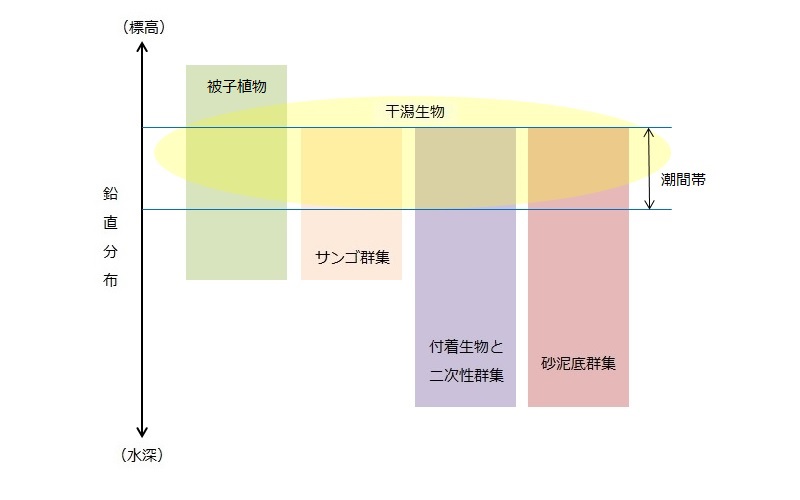
潮汐に応じて満ち潮の海面下に没したり、引き潮で大気に晒されたりする場所を潮間帯と呼びます。 その干満差は地形などによって様々で、最大15m(カナダのファンディ湾)〜数cm(日本海など)。 潮間帯には経時変化して気圏と水圏にわかれるふたつの位相があって、 干潮時と満潮時とでは生息する生物の活動がかなりはっきり区別されます。
干潟は潮間帯に現れる地形のひとつですが、砂泥底ばかりとは限らず、岩礁の露頭があったり、
サンゴ礁が発達していたりもしますので、単純に干潟生物という括りは不適当な気がします。
下図の干潟生物は砂浜生物と置き換えられると思います
(我々が俯瞰できる異なる次元が存在するわけですw)。
常々、干潟は日本古来の慣習に基づく呼称であって、学術的なものではないと考えていました。
実習生たちにも、干潟は定義されていない、と言ってきました。様々な成因と様相のものを
包括的に含んだ、言ってみれば多系統群ですw
ところが最近は環境省による定義があり、一定の広さを加味しています。ああっ、確かに。
そこへもってきて、大学の専攻分野なんかでも、理学部とかに留まらず、地球科学とか、惑星科学とか、
環境分野のなんだかパラメータの多い現象を扱おうっていう括りが増えたように思います
(民間アセスで扱ってきたような分野寄り、なのかもしれませんね)。であればぼくも、視点を改めねば
(砂浜生物も干潟生物も、なきゃあないで不便な言葉ですからw)。

アセス系の潮間帯調査は、もっぱら大潮の干潮時に行われます。自然海岸ならそれでもいいんですが、
コンクリートの垂直護岸なんて何メートルもの高所作業になって、かえって危険です。
満潮時にダイバー作業するのが最も効率が良いと常々思うんですけれど
(どうせフナムシだの双翅目昆虫だののデータはネグられちゃうんですし>< ←ガッカリしますよね)。
これまでに何度か提案したんですけどね orz
潮間帯の調査項目は、砂浜調査、干潟生物調査、付着生物調査、といった風に細分化されますが、
単に経済的な都合だと思います。船舶を使ったダイバー調査がもっとも予算のかかる項目ですし、
護岸の調査にビーチエントリーでは、安全面から許可が下りないでしょう。
”intertidal zone” という言葉の用例として古いものを探してみました
(リストは古い順, ネット上での閲覧, 未入手)。
南アフリカの潮間帯と海流の研究シリーズ最初の論文(1937年)が ”intertidal zone”
の最古の用例になるか、未入手のため不明です。1940年代のものを拾えていないのですが、
生態学の論文は1950年代以降にリストされています。
同様に、少なくとも1950年代には日本の生態学の研究者にも用いられるようになっています
(片田 1952
, Tokioka 1953, 1954
,Utinomi 1954
, etc.)。それ以前は
”between the low and high tide marks” なんて表現が使われています(Tokunaga 1933
, etc.)。
海洋学、地理学の論文を拾えていないので、見落としがあるかもしれませんけれど。
片田 實 1952潮位によって潮間帯を細分する試み. 生態学会報, 2(1): 9-12.
Tokioka, Takasi 1953Invertebrate fauna of the intertidal zone of the Tokara Islands-I. Introductory notes, with the outline of the shore and the fauna-. Publications of The Seto Marine Biological Laboratory, 3(2): 123-138.
Tokioka, Takasi 1954Invertebrate fauna of the intertidal zone of the Tokara Islands -VII. Ascidians-. Publications of The Seto Marine Biological Laboratory, 3(3): 239-264.
Tokunaga, Masaaki 1933Chironomida from Japan (Diptera). I.Clunionina. The Philippine Journal of Science, 51: 87-98.
Utinomi, Huzio 1954Invertebrate fauna of the intertidal zone of the Tokara Islands -IX. Cirripedia-. Publications of The Seto Marine Biological Laboratory, 4(1): 17-26.